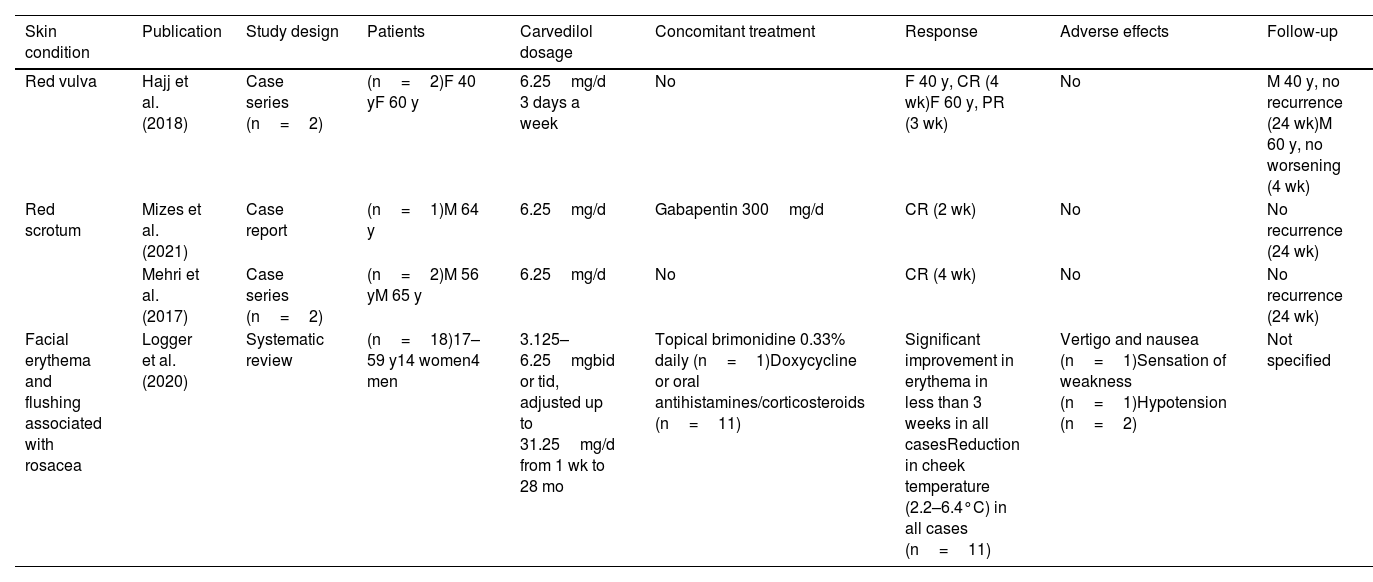Carvedilol is a nonselective β-blocker indicated for the treatment of essential hypertension, ischemic heart disease, and heart failure. In dermatology, it has proven useful as an off-label treatment for several skin conditions (Table 1). The most common adverse effects reported for standard doses are hypotension, dizziness, nausea, and weakness. These are typically mild and do not generally require dose adjustments or treatment discontinuation.
Summary of Cases in the Literature Evaluating the Effectiveness of Carvedilol for Different Skin Conditions.
| Skin condition | Publication | Study design | Patients | Carvedilol dosage | Concomitant treatment | Response | Adverse effects | Follow-up |
|---|---|---|---|---|---|---|---|---|
| Red vulva | Hajj et al. (2018) | Case series (n=2) | (n=2)F 40 yF 60 y | 6.25mg/d 3 days a week | No | F 40 y, CR (4 wk)F 60 y, PR (3 wk) | No | M 40 y, no recurrence (24 wk)M 60 y, no worsening (4 wk) |
| Red scrotum | Mizes et al. (2021) | Case report | (n=1)M 64 y | 6.25mg/d | Gabapentin 300mg/d | CR (2 wk) | No | No recurrence (24 wk) |
| Mehri et al. (2017) | Case series (n=2) | (n=2)M 56 yM 65 y | 6.25mg/d | No | CR (4 wk) | No | No recurrence (24 wk) | |
| Facial erythema and flushing associated with rosacea | Logger et al. (2020) | Systematic review | (n=18)17–59 y14 women4 men | 3.125–6.25mgbid or tid, adjusted up to 31.25mg/d from 1 wk to 28 mo | Topical brimonidine 0.33% daily (n=1)Doxycycline or oral antihistamines/corticosteroids (n=11) | Significant improvement in erythema in less than 3 weeks in all casesReduction in cheek temperature (2.2–6.4°C) in all cases (n=11) | Vertigo and nausea (n=1)Sensation of weakness (n=1)Hypotension (n=2) | Not specified |
Abbreviations: bid, twice a day; CR, complete response; F, female; M, male; PR, partial response; tid, 3 times a day.
In recent years, carvedilol has been proposed as a promising option for the treatment of flushing and persistent facial erythema in patients with rosacea who do not respond to conventional treatment. The mechanism of action seems to be related to blockade of the β2 adrenergic receptor, which induces vasoconstriction in the dermal plexus. It also decreases heart rate, which may further help improve facial redness.1 Mouse models have shown that carvedilol can reduce inflammatory reactions and erythema by inhibiting the TLR2 pathway in macrophages.2
The most common dosage for rosacea is 6.25 to 12.5mg 2 or 3 times a day. Improvements are usually observed within 2 to 3 weeks of treatment initiation and tend to last.1
Red ScrotumRed scrotum syndrome is characterized by persistent erythema of the scrotum associated with hyperalgesia and a burning sensation. It is a diagnosis of exclusion. None of the treatments used to date have shown consistent results, and patients who do respond usually need between 4 and 18 months for their symptoms to resolve. The literature contains cases reports of 2 patients with red scrotum who achieved a complete response to once-daily carvedilol 6.25mg after just 4 weeks of treatment. Neither of the patients developed adverse effects nor experienced recurrence after 6 months of treatment.3
Red VulvaRed vulva syndrome is a chronic condition of unknown etiology. It is characterized by persistent redness of the vulva, usually accompanied by pruritus and hyperalgesia. Similarly to in red scrotum syndrome, diagnosis is by exclusion.
Topical corticosteroids cannot be used continuously to treat red vulva syndrome, and, to date, no effective treatments have been identified. The literature contains 2 case reports of red vulva syndrome treated with carvedilol. Both patients showed a marked, rapid response (after 3 and 4 weeks of treatment) to carvedilol 6.25mg applied once daily 3 days a week; no adverse effects were reported.4
Prevention of CarcinogenesisCarvedilol has shown skin cancer preventive effects both in vivo and in vitro. Its inhibitory effect on carcinogenesis appears to be multifactorial. It protects against UV radiation–induced damage by regulating DNA repair mechanisms and also blocks reactive oxygen species and certain oncogenic signaling pathways such as PI3K/AKT. New topical preparations are being developed to avoid adverse effects caused by systemic absorption.5
Conflicts of InterestThe authors declare that they have no conflicts of interest.





